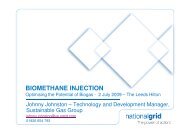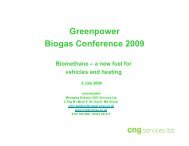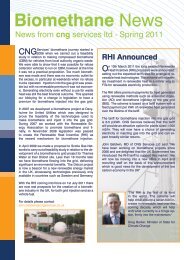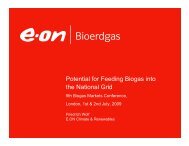Bio-SNG - CNG Services
Bio-SNG - CNG Services
Bio-SNG - CNG Services
Create successful ePaper yourself
Turn your PDF publications into a flip-book with our unique Google optimized e-Paper software.
BIO-<strong>SNG</strong> FEASIBILITY STUDY – ESTABLISHMENT OF A REGIONAL PROJECTThe biomass feedstock assumptions are shown in Table 6-4. These figures are based on a variety ofsources:The SRF data is based on knowledge of the industry for contracting SRF of this type of biogenic content.This is fuel which has been processed using biological drying. It must be noted that an SRF produced viaautoclaving would have a high biogenic content, but the energy penalty and therefore cost of processingwill be significantly higher.Woodchip. There would probably need to be an onsite drying facility for woodchip, which would entailadditional investment cost, opex and electrical loads, although it is possible to use low grade heat fordrying which might not otherwise be usable. However assuming a fuel price based on energy content(NCV), the additional drying using otherwise wasted heat is increasing the relative efficiency of the facility.In this analysis, this is assumed to compensate for the necessary drying investment and operationalcosts. The price assumption in Table 6-4 is from DECC‟s biomass fuel cost for large scale fuelgenerators, produced for the RHI evidence base 47 .Pellets command a significantly higher price than woodchip; this is a function of both the higherprocessing cost (energy required for drying to 10% moisture at the point of manufacture, along with theelectrical loads for hammer-milling and pelletising) as well as the enhanced out-turn product value due tothe enhanced fungibility compared with woodchip). .Again figures are taken from DECC‟s analysis.Waste wood may offer an alterative, feedstock, having a biogenic content of ~90% by energy. The plantwould need to handle contamination with the same degree of robustness as the SRF facility, andtherefore would need to assume the same capital cost as the SRF facility. However, the ash disposal costwould be lower. Initially the cost of the feedstock would be substantially lower than virgin biomass,potentially at zero cost or even with a small gate fee. However the expectation is that feedstock costwould increase substantially over time as demand for biomass increases and biomass combustionfacilities are constructed with the capability of co-firing waste wood with pure biomass. Securing wastewood of this quantity would be challenging. Therefore, whilst this could be a useful interim fuel, it has notbeen assumed as a base-case fuel.The DECC analysis does not provide predicted outturn prices for bulk biomass for 2020, althoughinterestingly for biomass heating applications, biomass prices are assumed to decrease relative to fossilfuels over a 2020 time frame. This is unlikely. In this analysis it is assumed that the escalation forbiomass is the same as for natural gas. This is a rationale assumption since the price will reflect, as aminimum the fuel which is being replaced. Arguably as the price of carbon impacts then the value of lowcarbon fuels may even increase faster than higher carbon intensity fuels.47 <strong>Bio</strong>mass prices in the heat and electricity sectors in the UK For the Department of Energy and Climate ChangeJanuary 2010 Ref: URN 10D/546 (Feb 2010)49









